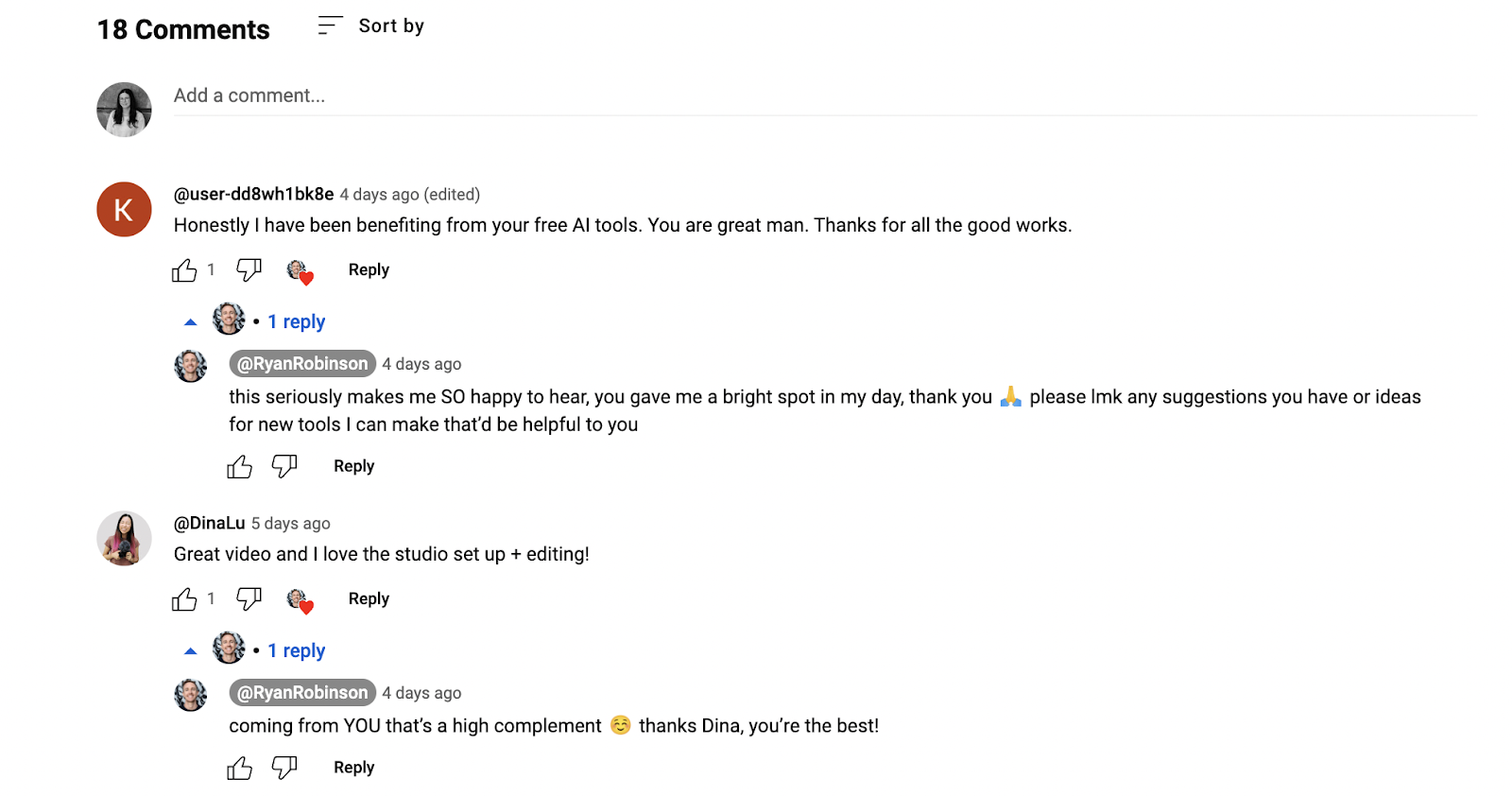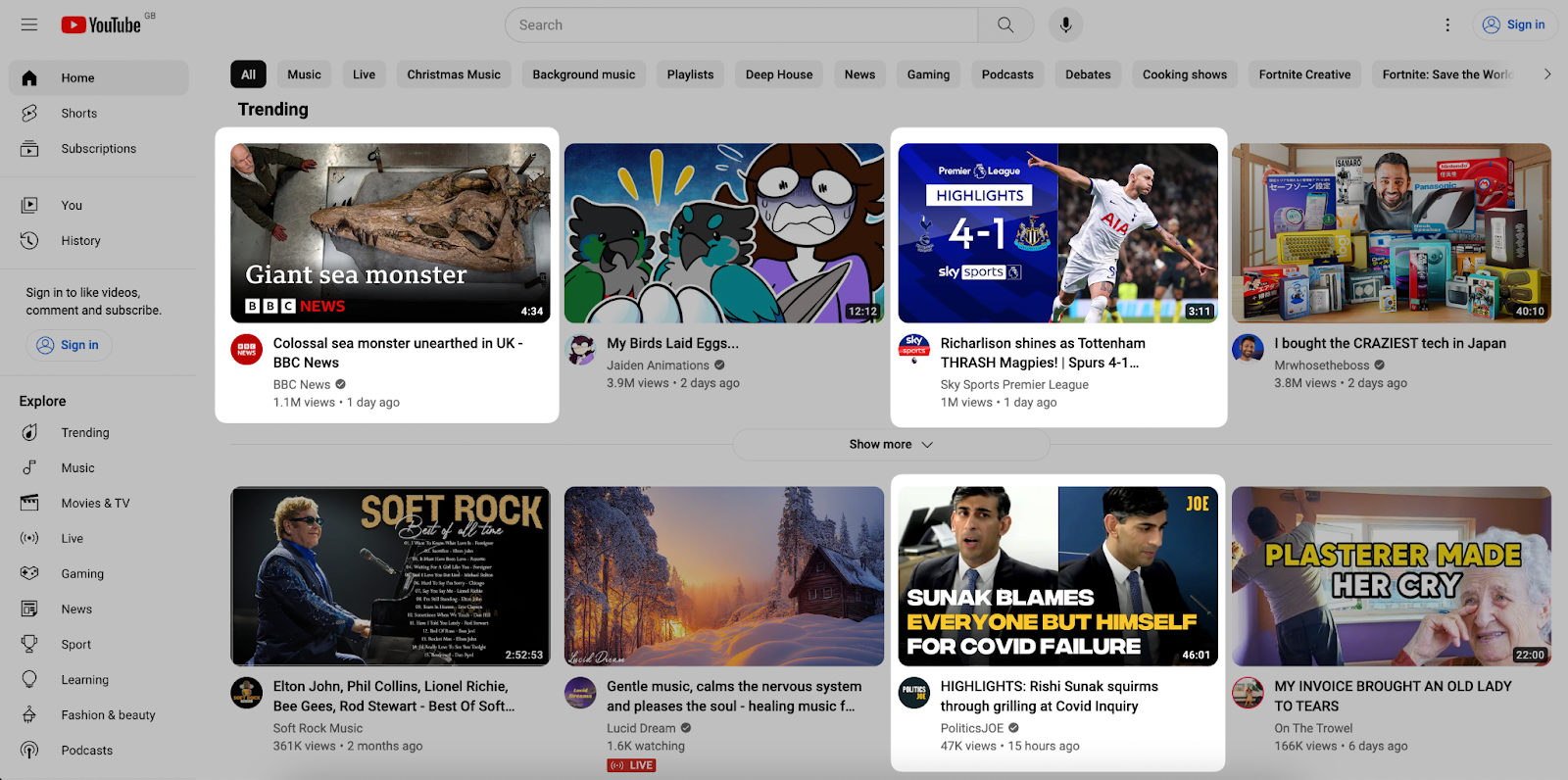YouTube is an incredible way to reach millions of viewers. It’s possible to do that overnight if your video goes viral—like the fastest-shared YouTube video that gained 400 million views in the first 24 hours.
A tiny percentage of videos uploaded to YouTube end up climbing to more than a million views. But while virality is often a matter of luck, there are some common denominators between top videos on the platform.
We’ll share some tried and true techniques for how to go viral on YouTube so you can increase the odds of reaching the right audience on the video-sharing platform and become a full-time YouTuber.
What is YouTube’s algorithm and how does it work?
The YouTube algorithm is the platform’s built-in search function that connects users with content they’re looking for. It combs through billions of videos to show an individual person the ones that best suit their query.
If you want to get more YouTube views, you need to know how the algorithm works:
- Relevance. If you searched “easy hairstyles” and were presented with a list of videos about the mechanics of a car, you’d be frustrated. YouTube’s algorithm considers how relevant a video is to the query using the video’s title and description.
- Quality. YouTube wants people on its platform for as long as possible. High-quality videos increase those odds—so make sure yours reach that quality bar. There’s no need for a viewer to leave if they’re enjoying quality content.
- User behavior. It’s not just about how long people spend on the platform. YouTube’s algorithm also takes into account how people interact with your video. A high number of views, shares, and comments indicate your video is engaging. That’s something YouTube wants to promote.
🧠 Hit a creative block? 50+ YouTube channel ideas for 2023
How does a YouTube video go viral?
Now we know how YouTube’s search engine works, let’s explore how it contributes to viral videos.
1. Unique and captivating content
Often, viral videos show things we don’t see every day. Take the “it’s corn!” video that went viral on YouTube back in 2022. It demanded our attention from multiple angles: it starred an adorable kid, it featured absurd and funny subject matter, and the song was an absolute banger.
This doesn’t mean your video has to slot within a particular type of content. Whether it’s educational, entertaining, or inspiring, you can create unique content in any video niche.
“Our algorithm doesn’t pay attention to videos, it pays attention to viewers. So, rather than trying to make videos that’ll make an algorithm happy, focus on making videos that make your viewers happy.” —YouTube
2. High production quality
Prioritize both the video and audio quality in your YouTube content to increase the odds of going viral. Remember: YouTube wants its users to stick around for as long as possible. Muffled sound or low resolution videos are more at risk of turning people away, hence why the algorithm sometimes ranks them lower.
With Descript, creating high-quality video content is simple. You can change the video resolution in a few clicks and remove background noise with Studio Sound. Both take less than 30 seconds.
Want to learn how to edit and publish professional-quality videos in Descript?
3. Optimized video thumbnails and titles
YouTube’s algorithm uses a video’s title and thumbnail to determine how relevant it is to a user’s search term. By optimizing (and A/B testing) both of these elements and using the keywords your target audience would search to find your content, you’ll increase the chances of going viral.
The fancy word for this is search engine optimization (SEO). It simply means to find the terms your audience is searching for, then include them in your:
- Video title
- Description (including hashtags)
- Video thumbnail
📚 Keep learning: 5 ways to use YouTube search trends for your next video idea
4. Timing and trends
What goes viral often depends on what’s popular or trending at the time. If you were to create a “what’s in my bag?” video in 2023, for example, you might be a little behind the times. The time to jump on that trend was back in the early 2010s when almost every creator showed the contents of their purse on camera.
The same concept applies to timing. If you post new content when people are active on the platform, you can get your first views early and prove to YouTube’s algorithm that this new, fresh content is something to take note of. Studies show that the best time to post on YouTube is between 2 p.m. and 4 p.m. (ET).

5. Community and engagement
YouTube isn’t just known for its video-sharing capabilities; it’s known for helping content creators build a community around their content. Viewers can like and comment on your videos, or subscribe to your YouTube channel if they want to see new content from you.
All of these things play a role in YouTube virality. Creators with a strong fan base can prove to YouTube’s algorithm that your content is high-quality since people watch new videos as soon as you upload. And, when they like, comment, and share your video, these are user behavior signals that influence how likely YouTube is to show your content to other users.
6. Shareability
We already know that YouTube wants people to stick around for as long as possible. But it also wants content creators to drive traffic to the website for them. Videos responsible for driving tons of traffic are rewarded with more visibility, so prioritize shareable content when trying to go viral.
👀 Get more views: The ultimate YouTube publishing checklist to maximize views
6 tips to make a viral YouTube video
- Collaborate with influencers
- Engage with viewers
- Lean on current events
- Create a strong hook
- Repurpose long videos into YouTube Shorts
- Cross-promote on social media
Collaborate with influencers
Influencers are people with lots of social media followers. When you collaborate with them to produce viral content for your YouTube channel, you’ll demand a viewer’s attention. Two of their favorite creators have made a video together. How could they not tune in?
Collaborating with influencers also helps you lean on their reputation to grow your view count. You can cross-promote new videos to an even bigger combined audience, helping you to get lots of views in the first few hours of your YouTube video going live.
Engage with viewers
The most successful YouTubers have a strong community around their channel. Do the same by engaging with your viewers. That might mean:
- Responding to their comments
- Answering questions in a future video
- Using “watch next” end cards to convince people to keep watching
Ryan Robinson is a YouTube creator that replies to every comment a subscriber leaves on his channel. It’s a simple technique that can bring people back for more, while also proving to YouTube that the video is worth promoting to other users.

Studies show that the average YouTuber (who has between 1,000 and 5,000 followers) has a 1.9% engagement rate. The higher you can raise this number, the better. It’ll not only prove to YouTube that your videos are worth showing to other users, but also open you up to more lucrative sponsorship deals. Brands pay big bucks for creators who have strong ties to their audience.
Lean on current events
It’s not just funny videos that go viral on YouTube. On this homepage, three out of eight trending videos are news related. News is a type of content that isn’t going anywhere—YouTube recently launched a “multi-format news watching experience” to capitalize on users who lean on the platform to stay updated with news and current events.

Jumping on news stories can help you reach a wider audience. If you’re a beauty creator and there’s a news story about a brand including dangerous chemicals in their products, for example, you could leverage it and create a viral video that explains how to understand the ingredients list in skincare products.
Create a strong hook
People decide whether to keep watching your YouTube video within the first few seconds. If you don’t grab their attention immediately, they might leave. This would indicate that your video isn’t interesting enough to keep people engaged and hinder how many people your video is displayed to.
As part of your video production process, focus on the hook. That could be a cold open—a script writing technique that uses intrigue to keep listeners interested. They need to keep watching to figure out what happens next.
You can also use video editing techniques to manufacture your hook in post-production, such as:
- Jump cuts to replicate action movies keep the video fast-paced
- Creating a montage—a small selection of video clips to show the viewer what’s coming
- Adding background music and sound effects to grab their attention
Repurpose long videos into YouTube Shorts
YouTube Shorts are short videos that YouTube is using to compete with TikTok and Instagram Reels. By including them in your video marketing strategy, you’ll claim your share of the 50 billion daily views YouTube Shorts receive—and give yourself more chances of going viral.
You don’t have to spend time creating new content from scratch. You can simply repurpose existing long-form videos into YouTube Shorts. Find Good Clips helps you repurpose your content in minutes, not hours. It uses AI to scan your video and find the best highlights, which you can quickly turn into YouTube Shorts with Descript’s video editor.

Cross-promote on social media
Viral videos often get an influx of views in the first 24 hours. Even if you don’t have a ton of YouTube subscribers to bump up that initial view count, you can lean on your social media followers to drive more views.
That could mean:
- Repurposing smaller clips to post on Instagram Reels or TikTok
- Sharing the link on industry forums where your target audience would hang out
- Using hashtags in posts to reach people on different social media platforms
Jeff Moriarty, marketing manager at Moriarty's Gem Art, says: “One of the best strategies we used for increasing our views and subscribers to over 85,000 was through social media, specifically Reddit. Many of our more in-depth videos we shared in topic-specific subreddits. They almost always were shared, commented on, and watched.
“One of our videos originally posted on YouTube has gone viral on Reddit quite a few times over the past couple years, resulting in over 6 million views to date,” Jeff says. “This is part of the reason why whenever we do a video, we always add it to Reddit.”
Create engaging YouTube content with Descript
Searching for a tool that’ll help you take bog-standard footage into viral YouTube videos? Look no further than Descript’s YouTube Editor.
It comes complete with AI features to speed up your video production workflow, including:
- Automated video transcription with <95% accuracy
- Find Good Clips to find the best video clips to repurpose
- AI Voices to fix mistakes in your audio without re-recording
- Eye Contact to readjust your gaze if you weren’t looking into the camera
- Green Screen to replace your background with an image or video
Some of the world’s top YouTube creators use Descript to edit their videos. Take a free trial today and experiment with premium features firsthand.



























%20(1).JPG)





